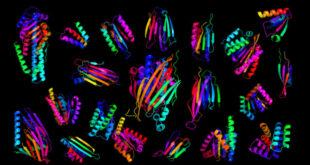New experimental antibiotics developed by chemists at the University of Connecticut successfully treat methicillin-resistant Staphylococcus aureus (MRSA) infections. The success is due to their strategy, which found a weakness and exploited it in a way the bacteria should have trouble countering.

Stephanie M. Reeve et al. identified two plasmid-borne genes that confer high-level resistance to trimethoprim for the first time in MRSA isolates from U.S. hospitals; a series of charged propargyl-linked antifolates overcome this resistance via direct inhibition of the acquired resistance elements. This colorized scanning electron micrograph depicts a grouping of MRSA bacteria. These bacteria are methicillin-resistant, and are from one of the first isolates in the U.S. that showed increased resistance to vancomycin as well. Note the increase in cell wall material seen as clumps on the organisms’ surface. Image credit: Janice Haney Carr / Public Health Image Library / CDC.
Cases of MRSA are on the rise and increasingly resistant to common antibiotics.
The first choice treatment for MRSA, trimethoprim-sulfamethoxazole, is relatively safe and inexpensive.
But trimethoprim-resistant MRSA has begun to spread around the globe. Up to 30% of infections in sub-Saharan African no longer respond to it, and significant numbers in Europe and Asia as well.
Dennis Wright, professor of medicinal chemistry at the University of Connecticut, and co-authors have been working to develop a drug that will be harder for MRSA to evolve resistance against.
“Although resistance to trimethoprim in the community is generally less than 10% in our local area, resistance elsewhere is climbing,” said co-author Dr. Michael Nailor, a pharmacologist at the University of Connecticut.
“Additionally, many vulnerable patient populations cannot take trimethoprim-sulfamethoxazole or other generic drugs because of side effects they may cause, and new agents are needed.”
The local samples showed just how fast antibiotic resistance is spreading. Six of nine bacterial strains collected had genes for trimethoprim resistance that had never before been seen in the United States.
The strains were also variously resistant to other antibiotics such as erythromycin and tetracycline. But they didn’t stand a chance against the experimental antibiotics from the team.
“One of the most exciting aspect of this work was that we had worked hard to design broadly acting inhibitors against many different resistant forms of the enzymes and these designs proved very effective against two new enzymes we had never considered or previously studied,” Prof. Wright said.
The strategic approach the researchers had taken was to target the bacteria’s use of vitamin B9.
Also known as folate, it’s as critical to MRSA bacteria as it is to us. Block its action and a vital enzyme pathway is shut down. The bacteria die.
Trimethoprim is currently the only antibacterial antifolate available, and bacteria have evolved different versions of the folate enzyme that aren’t impaired by it.
But Prof. Wright and his colleagues thought they should be able to make other, better antifolates.
They painstakingly analyzed the molecular structure of the enzyme they were up against, and exactly how it needed to interact with other molecules to do its job.
“Only by understanding its form and function could they foil versions of the enzyme they’d never seen before,” Prof. Wright said.
Armed with their knowledge, they designed new antifolates. These drugs are crafted to bind the enzyme in such a way that if the enzyme changes enough to evade them, it won’t be able to do its job with vitamin B9, either. That will hopefully make it harder for bacteria to evolve resistance.
The drugs’ success against the trimethoprim-resistant strains of MRSA sampled so far bodes well.
The team is now gathering more MRSA from across the country.
“We’d like to determine if the resistance mechanisms we discovered in our local MRSA strains are also found in other clinics throughout the United States,” said co-author Dr. Jeffrey Aeschlimann, associate professor of pharmacy at the University of Connecticut.
“We also may find other novel resistance mechanisms. In both cases, we will be able to gain even more valuable information about our how our new antibiotics work against MRSA.”
The team’s results were published in the Dec. 22, 2016 issue of the journal Cell Chemical Biology.
_____
Stephanie M. Reeve et al. 2016. MRSA Isolates from United States Hospitals Carry dfrG and dfrK Resistance Genes and Succumb to Propargyl-Linked Antifolates. Cell Chemical Biology 23 (12): 1458-1467; doi: 10.1016/j.chembiol.2016.11.007
This article is based on a press-release from the University of Connecticut.
 #Bizwhiznetwork.com Innovation ΛI |Technology News
#Bizwhiznetwork.com Innovation ΛI |Technology News



